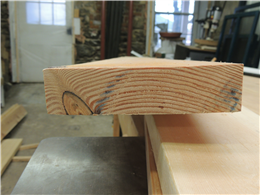Maintaining the Original Exterior Wood Features on Your Historic Building
There are many reasons why you should try to keep the original exterior wood features on your historic house or building. One of these reasons is the important historic preservation principle of striving to save original materials whenever possible. But historic wood also has physical properties that make your original wood features more valuable than new wood replacement materials.
Reason #1: Old Growth Wood is Stronger and More Rot Resistant
The wood siding and trim on your historic house or building was made with old-growth lumber that is structurally stronger and more rot-resistant than today’s lumber. As a tree gets older, it becomes hardier and its growth rings become tighter. The dense forests of the past also allowed trees to grow more slowly, making the older trees even sturdier.
Older-growth lumber was generally not available for house construction after 1940. Today's building lumber is made from plantation-grown trees that are between 12 and 20 years old. This new lumber is typically of lower quality, with fewer growth rings per inch than old-growth lumber.
Reason #2: Historic Lumber has Larger Dimensions
Lumber sizes have changed over the years. Lumber sizes are measured in two ways:
- Nominal lumber size means the actual dimensions before the lumber is dried and milled.
- Dimensional lumber size is the actual dimensions after the lumber is dried and milled, or the size of the lumber when it is delivered to the job site.
By the 1930s, the dimensional lumber size of exterior wood siding and trim began to shrink. In most historic houses built before the 1920s, “6-inch” clapboard was ½-inch thick at the butt end and a true 6 inches wide.
Today, that same 6-inch clapboard is around 3/8 inch thick and 5-1/2 inches wide. This smaller dimensional standard can present a problem if you try to match today’s lumber with the larger dimensional size of historic materials. The smaller materials will not join up well with the original materials and will create a different appearance on your house or building.
Reason #3: Historic Lumber Produces Less Warp

Logs are cut in three ways that each produce a different type of grain in the lumber. Source: WHS - State Historic Preservation Office
Wood harvested today is cut from the log in a different way today than it was historically. Most wood siding and trim today, and a small percentage of historic lumber, is plain sawn. This method of extracting boards from a log wastes the least amount of wood, but it also creates the least stable lumber.
Plain-sawn lumber is not straight grained, so it tends to have more problems with cupping and warping in a shorter period of time.

Looking at the direction and type of grain can tell you how the log was cut. Source: WHS - State Historic Preservation Office
Historically, most wood siding and trim was either rift sawn or quarter sawn. These two types of straight-grained lumber do not have problems with cupping or warping. Rift- and quarter-sawn lumber are still available today, but at premium prices.
Reason #4: Historic Wood Holds Paint Better
The typical exterior wood species used for exterior siding and trim on historic Wisconsin houses and buildings was pine, fir or cedar. All three of these softwoods are rated by the Forest Laboratory of the National Forest Service to hold paint well.
Hardwoods were rarely (if ever) used for exterior siding and trim. Hardwoods have a lot of tannic acid, which inhibits paint adhesion.
The straight-grained rift- or quarter-sawn lumber used historically for wood siding and trim holds paint better than today’s plain-sawn lumber.

